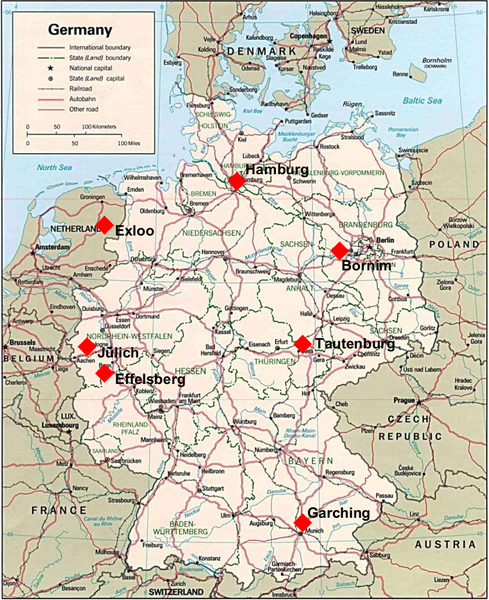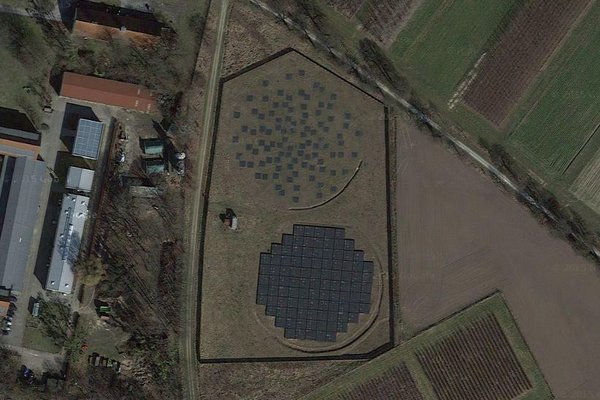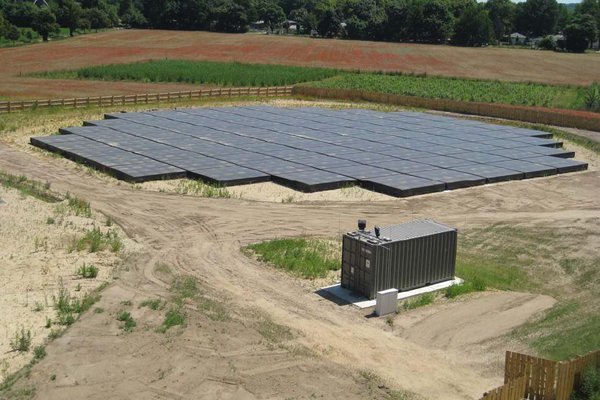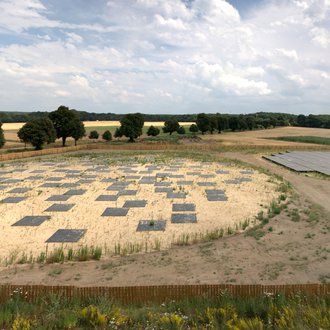LOFAR
Table of contents
LOw Frequency ARray (LOFAR)
LOFAR is a novel radio telescope that operates in the frequency range of 10 MHz - 250 MHz. It is currently being constructed by ASTRON at Exloo in the Netherlands. In its first construction phase it consists of about 40 sensor arrays. 20 of them form a compact core at Exloo with a diameter of 2 km. 20 stations are located farther away and approximately form logarithmic spirals in the northern Netherlands. This configuration reaches baselines of about 100 km.
A LOFAR station consists of two arrays of antennae for low (10 MHz - 90 MHz) and high (110 MHz - 250 MHz) frequencies, respectively. The antennae are simple dipole antennae. The gap between 90 MHz and 110 MHz avoids the FM radio range that inhibits observations with its strong background signals.
In "classical" radio interferometers an array of radio dish antennae is oriented towards the observed source in the sky. The antenna signals are correlated with well-defined delays, and an image is synthesized. With this setup, only a single source can be observed at a certain frequency at the same time. LOFAR pursues a different approach that offers an unprecedented flexibility and versatility. LOFAR uses arrays of simple dipole antennae that essentially cover the whole sky. At each LOFAR station, the antenna signals are digitized, pre-processed and sent to the Central Processing System (CPS) at Groningen, where signal correlation and further data processing is done. This design provides LOFAR with high flexibility and enables the simultaneous observations of up to 8 different sources in the sky. The long baselines of LOFAR provide an angular resolution in the arc-second range, and the large collecting area of all LOFAR stations combined leads to a sensitivity down to a mJy. Thus, it considerably exceeds the capabilities of current radio telescopes both in resolution and sensitivity.
LOFAR Key Science Projects
With its high sensitivity and flexibility, LOFAR is well suited for a wide variety of scientific topics, from the early Universe to Earth's space environment. For radioastronomical observations with LOFAR, special emphasis is on the following "Key Science Projects":
- Solar Physics and Space Weather
The Sun is an intense radio source. Bursts of solar radio emission are closely connected to the phenomena of the active Sun, like flares and coronal mass ejections. The solar activity has strong implications on Earth and its space environment. These connections are summarized under the term space weather. In the Key Science Project "Solar Physics and Space Weather with LOFAR" these phenomena are studied. - Epoch of Reionization
LOFAR will observe the 21 cm line of neutral hydrogen from the epoch of reionization of the early Universe. This way, it will gain information on the first stars and galaxies, as well as on structure formation in the early Universe. - Deep Extragalactic Surveys
LOFAR will map the sky with high sensitivity, and will provide catalogues of radio sources. The applications range from black holes over galaxies to galaxy clusters. Discoveries of new phenomena are expected. - Transient Events
Regular monitoring of a large part of the sky will reveal variable radio sources, and leads to the discovery of transient events. Candidates for such radio outbursts are flare stars, X-ray binaries, supernovae, and gamma ray bursts. - Cosmic Magnetism
Cosmic ray particles emit synchrotron radiation in the weak magnetic fields of galaxies, that is observable with LOFAR. This way, magnetic fields in distant galaxies can be determined, leading to new insights in galactic dynamics. - Ultra High Energy Cosmic Rays
If a highly energetic cosmic ray particle hits an atom in Earth's atmosphere, a cascade of secondary particles is released. Such a cascade emits a flash of radio waves. LOFAR observations of these flashes shed light on the sources of cosmic rays.
Solar radioastronomy with LOFAR
Solar radio emission in the LOFAR frequency range originates from the middle and upper corona. Thus, and with its imaging capability, LOFAR is well appropriate e.g. to study the release of coronal mass ejections (CMEs) and to estimate their potential impact on Earth. This is of great importance for space weather research.
At low frequencies, only a few instruments with imaging capability observe the Sun. E.g., the radioheliograph at Nancay, France, is operated on selected frequencies ranging from 150 MHz - 432 MHz and yields an image resolution of up to 1'. LOFAR will dramatically improve the situation with routine observations, and will expand the frequency range down to 10 MHz. With simultaneous observations at several frequencies, it will be possible to probe different heights in the corona, and to reveal structures in coronal radio sources that are yet unexplored. LOFAR's flexibility enables different observation modes that are tailored to different scientific objectives:
- Response to solar radio bursts
Since the control of LOFAR is basically realized in software, it is possible to react quickly on changes in the solar activity. If a continuously operated solar radio spectrometer, e.g. the Observatory for Solar Radioastronomy, detects a radio burst ("burst bell"), follow-up observations with LOFAR can be triggered, e.g. a rapid sequence of images in different frequencies. - Routine monitoring of the solar activity
Continuous monitoring of the Sun allows for studies of the long-term evolution of solar active regions and provides information on the precursors of solar radio bursts, flares, and CMEs. Continuous imaging would comprise a sequence of 1 image per minute. Such observations can be ideally combined with optical images, like the H alpha images of the Kanzelhöhe Solar Observatory. - Space weather studies
The phenomena of the active Sun, like flares and CMEs, can have severe impact on the terrestrial environment. This relationship is usually referred to as Space Weather. LOFAR's frequency range covers radio source locations in the upper corona, this is the region where CMEs start towards interplanetary space. With LOFAR images of a nascent CME it is possible to estimate its potential impact on Earth. - Observation campaigns
Simultaneous observations at different wavelength ranges are useful for a better understanding of the physical processes in flares and CMEs. Highly energetic electrons in the solar atmosphere do not only emit radio waves, but also X-rays, while the heating of the corona in a flare leads to EUV emission, and the effects of a flare on the chromosphere are observable in optical and millimeter wavelengths. Thus, joint observation campaigns with X-ray telescopes like STIX on Solar Orbiter, the Japanese Hinode or Solar Dynamics Observatory of NASA, are as reasonable as with optical telescopes like GREGOR or millimetre wave telescopes like ALMA.
For studies of CMEs and and energetic electrons causing type III radio bursts, joint observations with LOFAR and space-based radio receivers are useful, since the frequency of radio emission decreases with increasing distance from the Sun, and ground-based observations of frequencies below 10 MHz are not possible due to ionospheric reflection. Such space missions are Solar Orbiter and Parker Solar Probe, who also can provide in-situ observations of energetic electrons. - Single station as a spectrometer
Beside of the previously presented observation modes that make use of the whole LOFAR system for image synthesis, there is also the possibility to use only a single station for solar observations. This could be possible if e.g. a LOFAR observing program only uses the central core, and remote stations like that at Bornim are available. In this case, the radio spectrum of the Sun is observed in selected frequency intervals starting from 30 MHz. Such a program makes optimal use of the resources of the LOFAR telescope.
More information on solar radio astronomy with LOFAR is available in our brochure Solar Physics with LOFAR (PDF, 1071 KB).
Further scientific interest in LOFAR at the AIP
LOFAR is a powerful and flexible radio telescope that is useful for many scientific applications. Both research areas of the AIP have the following interests beside solar physics:
- Solar-stellar connections
The Sun is the only star that can be observed directly from Earth with imaging telescopes. Investigation of the Sun as a typical main sequence star is thus of great interest for stellar astrophysics. - Extragalactic astronomy
LOFAR is capable of observing the formation and evolution of galaxies, galaxy clusters, and active galactic nuclei (AGNs), as well as the epoch of reionization of matter in the early Universe due to the UV light of the first stars and quasars. - Galactic astronomy
With LOFAR it will be possible to study the absorption and polarization of radio waves in the interstellar medium, as well as shocks and particle acceleration at supernova remnants. - All sky surveys
LOFAR will produce radio maps of the whole sky visible from Central Europe with unprecedented sensitivity and angular resolution. The discovery of many new objects can be expected. - Data science
LOFAR observations produce large amounts of data. Their processing and storage requires a suitable infrastructure. Thus, E-science is an essential component of the LOFAR project. The Verein für Datenintensive Radioastronomie (VdR) coordinates the efforts of handling large amounts of radio astronomical data in Germany.
LOFAR stations in Germany - GLOW

A group of German institutes interested in LOFAR, e.g. the AIP or the MPI for radioastronomy, have founded the German LOng Wavelength consortium (GLOW).
The GLOW partners operate a total of 6 LOFAR stations in Germany, including the one of AIP at Potsdam - Bornim.
For further information on the LOFAR activities in Germany, see http://www.lofar.de.
LOFAR Station at the AIP at Bornim
The AIP operates a LOFAR station at Potsdam-Bornim (52.438° N, 13.016° E). The picture shows an aerial view of the site. The low- (10 - 90 MHz) and high-band (110 - 250 MHz) antenna fields, each with a diameter of 70 m, are clearly visible. This location has the advantage that it is possible to connect it with a fast data link of 5 GBit/s, that is necessary for operating a LOFAR station, via the neighbouring Leibniz-Institut für Agrartechnik und Bioökonomie (ATB)

LOFAR-Station in Potsdam-Bornim, with low- (top) and high-band antenna fields (bottom).

LOFAR-Station in Bornim.
Credit: AIPPartners:
LOFAR has been designed and constructed by ASTRON. It has observing, data processing, and data storage dacilities in several countries, which are collectively operated by the International LOFAR Telescope (ILT) foundation. The German Long Wavelength Consortium (GLOW) coordinates the participation of partner institutes in Germany in LOFAR.
Involved AIP sections and groups:
Solar Physics, IT Services, Technical Section, Supercomputing and E-Science